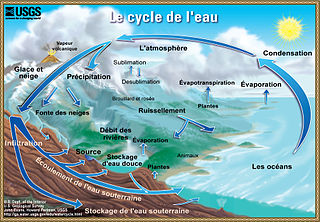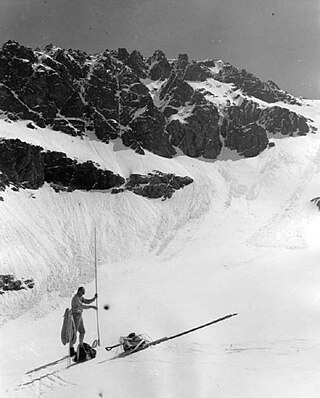Related Research Articles

Hydrology is the scientific study of the movement, distribution, and management of water on Earth and other planets, including the water cycle, water resources, and drainage basin sustainability. A practitioner of hydrology is called a hydrologist. Hydrologists are scientists studying earth or environmental science, civil or environmental engineering, and physical geography. Using various analytical methods and scientific techniques, they collect and analyze data to help solve water related problems such as environmental preservation, natural disasters, and water management.

The Byrd Polar and Climate Research Center (BPCRC) is a polar, alpine, and climate research center at The Ohio State University founded in 1960.
Robert Elmer Horton was an American hydrologist, geomorphologist, civil engineer, and soil scientist, considered by many to be the father of modern American hydrology. An eponymous medal is awarded by the American Geophysical Union (AGU) to recognize outstanding contributions to the field of hydrological geophysics. The AGU Hydrology section was formed largely due to his personal property that was bequeathed to AGU.

Hydrometeorology is a branch of meteorology and hydrology that studies the transfer of water and energy between the land surface and the lower atmosphere. Hydrologists often use data provided by meteorologists. As an example, a meteorologist might forecast 2–3 inches (51–76 mm) of rain in a specific area, and a hydrologist might then forecast what the specific impact of that rain would be on the local terrain.

An hydrological transport model is a mathematical model used to simulate the flow of rivers, streams, groundwater movement or drainage front displacement, and calculate water quality parameters. These models generally came into use in the 1960s and 1970s when demand for numerical forecasting of water quality and drainage was driven by environmental legislation, and at a similar time widespread access to significant computer power became available. Much of the original model development took place in the United States and United Kingdom, but today these models are refined and used worldwide.

The Czech Hydrometeorological Institute is the central state office of the Czech Republic in the fields of air quality, meteorology, climatology and hydrology. It is an organization established by the Ministry of the Environment of the Czech Republic. The head office and centralized workplaces of the CHMI, including the data processing, telecommunication and technical services, are located at the Institute's own campus in Prague.
The International Association of Hydrological Sciences (IAHS) is a non-profit, non-governmental scientific organization committed to serving the science of hydrology and the worldwide community of hydrologists. The IAHS was established in 1922, and presently claims a membership in excess of 9,000 with members in over 150 countries.
There is a long and established framework for water resources management in Colombia. The Environment Ministry and up to 33 Regional Authorities, are in charge of water resources management and policies at the national and regional and watershed level, respectively. Other sectoral ministries are in charge of water demand for energy, water supply and sanitation and water for irrigation.
The following outline is provided as an overview of and topical guide to hydrology:

The Croatian Meteorological and Hydrological Service is a public entity for meteorology, hydrology and air quality in Croatia.
RheinBlick2050 is an environmental science research project on the impacts of regional climate change on discharge of the Rhine River and its major tributaries in Central Europe. The project runtime was from January 2008 until September 2010, initiated by and coordinated on behalf of the International Commission for the Hydrology of the Rhine Basin (CHR).

The Latvian Environment, Geology and Meteorology Centre is a governmental service under the Ministry of Environmental Protection and Regional Development of Latvia.
Hydrometeorological Institute of Montenegro is the national hydrological and meteorological service of Montenegro.
Hydrologic Research Center (HRC), founded in 1993, is a public-benefit non-profit research, technology transfer, and science cooperation and education organization, dedicated to the development of effective and sustainable solutions to global water issues. HRC's purpose is to provide a conduit for academic and other up-to-date research to be made suitable for effective application to field operational problems that involve water management and flood disaster mitigation. The vision of HRC is to assist in limiting societal vulnerability and preserving resiliency in basic human needs, livelihoods, agriculture, water resources, healthy ecosystems, and natural resources. Around the world flash flooding and flooding are the most common natural disasters and the leading cause of natural disaster fatalities worldwide – 40% of all natural disasters.
The flash flood guidance system (FFGS) was designed and developed by the Hydrologic Research Center, a non-profit public-benefit corporation located in San Diego, CA, US, for use by meteorological and hydrologic forecasters throughout the world. The primary purpose of the FFGS is to provide operational forecasters and disaster management agencies with real-time information pertaining to the threat of small-scale flash flooding throughout a specified region.

Wendell Tangborn was an American glaciologist specializing in glacier mass balance measurements since 1960, chiefly within the states of Washington and Alaska of the Pacific Northwest.
The National Centre for Hydro-Meteorological Forecasting is a National meteorological service of Vietnam. It belongs to Vietnam Meteorological and Hydrological Administration (VMHA) under the Ministry of Natural Resources and Environment with authority to issue forecasting/warning information for weather, climate, hydrology, water resource, marine weather and provide hydro-meteorology services.
Nina Vankova Nikolova is a Bulgarian climatologist, and a professor at Sofia University.

LamaH is a cross-state initiative for unified data preparation and collection in the field of catchment hydrology. Hydrological datasets, for example, are an integral component for creating flood forecasting models.
References
- ↑ World Meteorological Service list of members Archived 2013-10-13 at the Wayback Machine
- ↑ A. Laraque, J. Ronchail, G. Cochonneau, R. Pombosa, and J.L. Guyot. "Heterogeneous Distribution of Rainfall and Discharge Regimes in the Ecuadorian Amazon Basin." (Dec. 2007). Journal of Hydrometeorology. Vol. 8, no. 6, pp. 1364-1381.